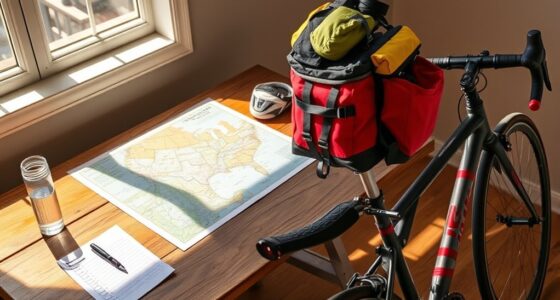To plan a cycling vacation in Europe, start by choosing a destination that matches your fitness level and interests, like Tuscany or the French Riviera. Map out scenic routes using GPS apps, balancing daily distances with rest stops. Book accommodations early and consider cycling tour packages for added support. Learn local cycling laws and customs to stay safe, and organize your gear and transport options. If you keep exploring, you’ll find tips to help create an unforgettable adventure.
Key Takeaways
- Research scenic cycling regions, considering terrain, climate, and personal experience, and choose the best time to visit for optimal weather.
- Map out a manageable route with designated stops, balancing distances, elevation, and sightseeing opportunities.
- Book accommodations in advance, prioritizing secure bike storage, and plan logistics for bike transport or rentals.
- Familiarize yourself with local cycling laws, customs, and language basics to ensure safety and cultural respect.
- Prepare your gear, including maintenance tools, safety equipment, and necessary documents, to handle contingencies smoothly.

Planning a cycling vacation in Europe can be an exciting adventure, but it requires careful preparation to guarantee you make the most of your trip. The first step is choosing your destination wisely. Europe offers diverse landscapes, from the rolling hills of Tuscany to the scenic coastlines of the French Riviera, so think about what scenery excites you most. Contemplate your fitness level and cycling experience to select a route that matches your abilities. Research popular cycling regions and read reviews from fellow travelers to get a sense of what each offers. Once you’ve pinpointed a location, look into the best time of year to visit. Spring and early fall often provide mild weather and fewer crowds, making for more enjoyable rides.
Choose your European cycling destination based on scenery, your fitness level, and local reviews for an unforgettable adventure.
Next, plan your route thoroughly. Use detailed maps or cycling-specific GPS apps to chart a course that balances scenic views with manageable distances. Decide whether you’ll follow dedicated bike paths, quiet country roads, or a mix of both. Be realistic about daily distances; overexerting yourself on the first day can dampen your enthusiasm for the trip. Incorporate rest days or shorter rides to recover and explore local sights without rushing. Check the elevation profiles to prepare for hills and challenging terrains, and plan your stops at interesting towns, cafes, or landmarks along the way. Ensuring you understand the local regulations, including payment methods, can also be beneficial if you plan to purchase supplies or services during your trip. Additionally, understanding local cycling laws can help you stay compliant and safe on your journey. Researching local customs and cultural norms can also enhance your overall experience and interactions with residents.
Accommodations are another essential aspect to contemplate. Decide if you want to stay in hotels, guesthouses, or even opt for cycling-specific accommodations that cater to cyclists with secure bike storage. Booking in advance is advisable, especially during peak travel seasons. Some regions offer cycling tour packages that include lodging, guides, and support, which can be a stress-free way to explore if you prefer organized trips. Packing smart is critical—bring lightweight, moisture-wicking clothing, essential repair tools, spare tubes, and comfortable footwear for evenings. Don’t forget your helmet, reflective gear, and a small first-aid kit. Proper planning can also involve researching local bike rental options if you decide not to bring your own bike, which can sometimes simplify logistics.
Lastly, familiarize yourself with local regulations and customs. Learn basic phrases in the local language, understand road signs, and respect local cycling laws. Planning ahead also means arranging travel logistics, such as how you’ll get your bike to Europe—whether by shipping it, flying with an airline that permits bikes, or renting bikes locally. Ensure your bike is well-maintained and suited for the terrain. Proper preparation will boost your confidence and allow you to focus on enjoying the journey, soaking in the scenery, and discovering hidden gems along the way. With these steps, you’re well on your way to an unforgettable European cycling adventure.
Frequently Asked Questions
What Is the Best Time of Year for a Cycling Vacation in Europe?
The best time of year for a cycling vacation in Europe depends on your preferences. Generally, late spring (May-June) offers warm weather, blooming landscapes, and fewer crowds. Summer (July-August) is popular but busier. Early fall (September-October) provides pleasant temperatures and stunning foliage. Avoid winter months if you prefer mild weather, as some regions can be cold and rainy. Choose based on your ideal climate and the destinations you want to explore.
Are There Age Restrictions for Cycling Tours Across Europe?
You might think there’s a strict age limit for cycling tours across Europe, but that’s not true—you can find adventures for every age! Many companies tailor tours to different fitness levels and ages, from energetic teens to seasoned seniors. As long as you’re comfortable with your bike and able to handle the terrain, you’ll find plenty of options. Always check specific tour requirements, but age isn’t usually a barrier.
Do I Need Special Insurance for Cycling Holidays?
You should definitely consider special insurance for your cycling holiday. Standard travel insurance may not cover cycling-specific accidents or theft, so look for policies that include adventure or sports coverage. This way, you safeguard yourself against potential injuries, bike damage, or loss. Always read the policy details carefully to ensure it covers the activities you plan to do. Having the right insurance gives you peace of mind, so you can enjoy your trip fully.
How Do I Handle Language Barriers While Cycling in Europe?
Finding your way through language barriers in Europe can feel like trying to read a map in a fog. You should learn basic phrases, carry a translation app, and keep a smile on your face. Gestures and visual cues work wonders when words fail. Respect local customs, and you’ll find people enthusiastic to help. Preparation and patience turn language challenges into opportunities for genuine cultural exchanges during your cycling adventure.
What Are the Options for Supporting Vehicles or Guides?
When considering options for supporting vehicles or guides, you can choose guided tours that include support vans, which carry your gear and offer assistance if needed. Alternatively, rent a support vehicle separately or arrange for a local guide who knows the routes well. These options give you peace of mind, ensuring help is available, and allow you to focus on enjoying your ride without worry.
Conclusion
Now that you’ve mapped out your European cycling adventure, you’re ready to turn the open road into your personal storybook. Embrace every twist and turn like a painter adding vibrant strokes to a masterpiece, and let the wind be your guide. With your preparations in place, this journey will unfold like a beautiful tapestry—full of discovery, freedom, and unforgettable moments. So, gear up and pedal boldly into the horizon—your European escape awaits!









